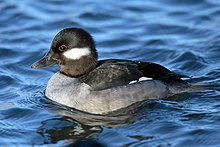Bufflehead
| Bufflehead | |
|---|---|
 |
|
| Male | |
 |
|
| Female | |
| Scientific classification | |
| Kingdom: | Animalia |
| Phylum: | Chordata |
| Class: | Aves |
| Order: | Anseriformes |
| Family: | Anatidae |
| Subfamily: | Merginae |
| Genus: | Bucephala |
| Species: | B. albeola |
| Binomial name | |
|
Bucephala albeola (Linnaeus, 1758) |
|
| Synonyms | |
Anas albeola Linnaeus, 1758
Charitonetta albeola
The bufflehead (Bucephala albeola) is a small sea duck of the genus Bucephala, the goldeneyes. This species was first described by Linnaeus in his Systema naturae in 1758 as Anas albeola.
The genus name is derived from Ancient Greek boukephalos, "bullheaded", from bous, "bull " and kephale, "head", a reference to the oddly bulbous head shape of the species. The species name albeola is from Latin albus, "white". The English name is a combination of buffalo and head, again referring to the head shape. This is most noticeable when the male puffs out the feathers on the head, thus greatly increasing the apparent size of the head.
The bufflehead ranges from 32–40 cm (13–16 in) long and weighs 270–550 g (9.5–19.4 oz), with the drakes larger than the females. Averaging 35.5 cm (14.0 in) and 370 g (13 oz), it rivals the green-winged teal as the smallest American duck.
Adult males are striking black and white, with iridescent green and purple heads and a large white patch behind the eye. Females are grey-toned with a smaller white patch behind the eye and a light underside.
They are migratory and most of them winter in protected coastal waters, or open inland waters, on the east and west coasts of North America and the southern United States. The bufflehead is an extremely rare vagrant to western Europe. Their breeding habitat is wooded lakes and ponds in Alaska and Canada, almost entirely included in the boreal forest or taiga habitat.
Buffleheads have evolved their small size to fit the nesting cavity of their "metabiotic" host, a woodpecker, the northern flicker. Due to their small size, they are highly active, undertaking dives almost continuously while sustained by their high metabolism. They do not tend to collect in large flocks; groups are usually limited to small numbers. One duck serves as a sentry, watching for predators as the others in the group dive in search of food. Buffleheads are amongst the last waterfowl to leave their breeding grounds and one of the world's most punctual migrants, arriving on their wintering grounds within a narrow margin of time.
...
Wikipedia

